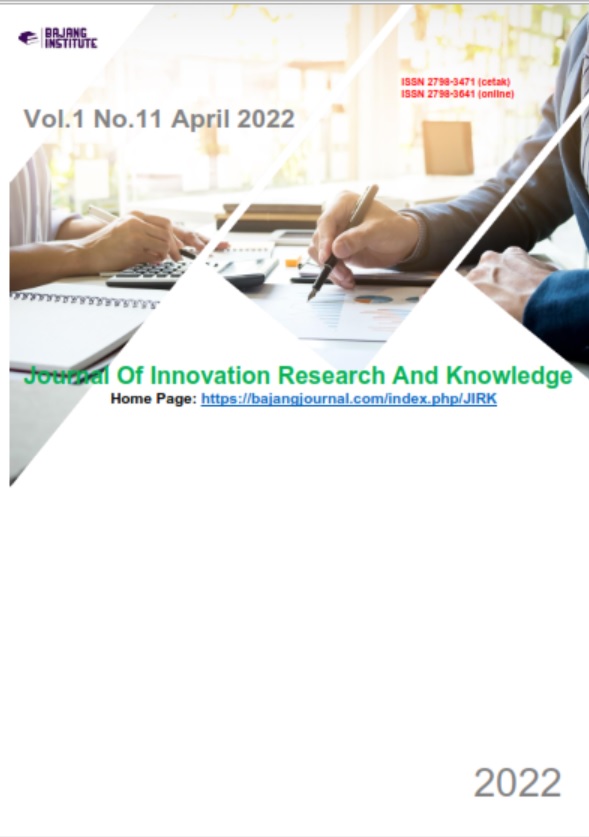PEMANFAATAN EKSTRAK DAUN KEMANGI UNTUK MENCEGAH PERTUMBUHAN LARVA ANOPHELES ACONITUS
DOI:
https://doi.org/10.53625/jirk.v1i11.6887Keywords:
Anophels, Daun Kemangi, Larva, MalariaAbstract
Malaria adalah penyakit infeksi yang secara alami ditularkan melalui gigitan nyamuk Anopheles betina. Ekstrak daun kemangi (Ocimum sanctum) memiliki efek larvasida terhadap larva Anopheles aconitus. Tujuan penelitian untuk mengetahui efek larvasida ekstrak daun kemangi (Ocimum sanctum) terhadap larva Anopheles aconitus. Metode Penelitian ini bersifat eksperimental laboratorik yang menggunakan rancanganpenelitian the post test only controlled group design. Hasil penelitanData hasil uji pendahuluan, sebagaimana tercantum dalam tabel 1 dianalisis Probit dan didapatkan hasil LC50 = 0,658% dan LC99 = 2,063%. asil ini yang mendasari penentuan konsentrasi ekstrak daun kemangi ungu yang dipakai pada penelitian.
References
Anees A.M. 2008. Larvicidal activity of Ocimum sanctum Linn. (Labiatae) against Aedes aegypti (L.) and Culex quinquefasciatus (Say). Parasitol Res. 103, pp:1451–1453.
Azhari H.N., Salah A.E, Nour A.O., Abduelrahman H.N. and Mashitah M.Y. 2009. A Study of the Essential Oils of Four Sudanese Accessions of Basil (Ocimum basilicum L.) Against Anopheles Mosquito Larvae. American Journal of Applied Sciences. 6(7), pp: 1359-1363.
Bappenas, 2009. Memerangi HIV/AIDS, Malaria, Dan Penyakit Menular Lainnya. www.bappenas.go.id/get-file server/node/1206/ (24 September 2009).
Centers for Disease Control and Prevention, 2008. Anopheles mosquitoes. http://www.cdc.gov/Malaria/biology/mosquito/ (24 September 2009).
Chopra D. 2009. Plantamor Informasi Spesies Kemangi ( Ocimum sanctum L.). http://www.plantamor.com/index.php?plant=914. ( 24 September 2009).
Christophers S.R. and Barraud P.J. 1931. The Eggs of Indian Anopheles with Descriptions of the Hitherto Undescribed Eggs of A Number of Species. Records of the Malaria Survey of India. 2(1), pp: 23-30.
Dahlan M.S. 2008. Statistik untuk Kedokteran dan Kesehatan. Jakarta: Salemba Medika, hh: 84-95.
Dattani M. 2009. Ocimum Sanctum And Its Therapeutic Applications. http://www.pharmainfo.net/reviews/ocimum-sanctum-and-its-therapeutic-applications. (28 September 2009). Dewi S.P2007. Tanaman ObatIndonesia. http://toiusd.multiply.com/journal/item/110/Ocimum_sanctum-068114098. (8 Oktober 2009).
Depkes RI. 1983. Malaria Entomologi jilid 10. Jakarta: Dirjen Pemberantasan dan Pencegahan Penyakit Menular, hh: 9-17.
Depkes RI. 1989. Kunci Bergambar Identifikasi Jentik Anopheles di Indonesia. Jakarta: Dirjen Pemberantasan dan Pencegahan Penyakit Menular, hh: 7-20.
Depkes RI. 2003. Pedoman Tata Laksana Kasus Malaria (Gebrak Malaria). Jakarta: Dirjen Pemberantasan dan Pencegahan Penyakit Menular, hh: 1-3
Duke J. 2009. Phytochemical and Ethnobotanical Databases (Ocimum sanctum). http://sun.ars-grin.gov:8080/npgspub/xsql/duke/plantdisp.xsql?taxon=2021 (4 Oktober 2009)
Fatimah S. 1997. Studi Laboratorium Uji Kepekaan Larva Anopheles aconitus terhadap Ekstrak Ocimum basilicum. Semarang, UNDIP. Skripsi.
Gambiro S.K.M. 2007. Kebijakan Pemerintah dalam Pemberantasan Penyakit-penyakit Parasit di Indonesia (Terutama Malaria dan Filariasis). Depkes RI, h: 6.
Gandahusada S., Ilahude H.D. dan W Pribadi. 1998. Parasitologi Kedokteran. Jakarta: Balai Penerbit FK UI, hh: 220-224.
Hanifah K.A. 1993. Rancangan Percobaan Teori dan Aplikasi. Jakarta: Rajawali Press, h: 35.
Harijanto P.N. 2000. Malaria Epidemiologi, Patogenesis, Manifestasi, Klinis dan Penanganan. Jakarta: Penerbit EGC, hh: 4-7.
Harrison B.A. 1980. The Myzomyia Series of Anopheles (Cellia) In Thailand With Emphasis on Intra-Interspecific Variations. Medical Entomology Studies-XIII. 17(8), p: 160.
Isman M. 1999. UBC Researcher Helps Develop Environmentaly Saf Pesticide. http://www.publificaffairs.ubc.ca/media/releases/1999/mr-99-61.html. (12 Maret 2009).
Kitti S. 1996. Kimia I. Klaten: PT. Intan Pariwara, hh: 37-38.
Kweka E.J., Franklin M., Asanterabi L., Aneth M.M., Jovin K., Johnson M., Michael J.M., Charles P.M, Filemoni T., Emmanuel F., Ester E.L., Michael A.M, Rajabu M., Grace C. and Emmanuel A.T. 2008. Ethnobotanical Study of Some of Mosquito Repellent Plants in North-Eastern Tanzania. Malaria Journal. 7, pp:152.
Maesaroh S. 2005. Daya Bunuh Larvasida Ekstrak Bawang Putih (Allium Sativum Linn) Terhadap Larva Vektor Malaria Anopheles Aconitus Donitz.
Matsumura F. 1975. Toxicology of Insecticides. New York: Plenum Press, pp: 17-22.
Novizan. 2002. Membuat dan Memanfaatkan Pestisida Ramah Lingkungan. Jakarta: Agromedia Pustaka, hh: 37-40.
Nugroho H.B. 2004. Pengaruh Pemberian Ekstrak Buah Tomat (Solanum lycopersicum L.) terhadap Jumlah Kematian Larva Anopheles aconitus. http://www.unissula.ac.id/perpustakaan/index.php?option=com_content&view=article&id=304:pengaruh-pemberian-ekstrak-buah-tomat-solanum-lycopersicum-l-terhadap jumlah-kematian-larva anopheles=37:skripsi-kedokteran&Itemid=58. (9 Maret 2010).
Okie S. 2008. A New Attack on Malaria. New England Journal Medicine. 358, p: 23
Payton M.E., Greenstone M. and Schenker N. 2003. Overlapping Confidence Intervals or Standard Error Intervals What Do They Mean In Terms of Statistical Significance. Journal of Insect Science. 3, p: 34.
Sembel D.T. 2009. Entomologi Kedokteran. Yogyakarta: Penerbit Andi. hh:10-14.
Seyoum A., Ephantus W.K., Wilber L., Gerry F.K., Ahmed H. and Bart G.J.K. 2002. Repellency Of Live Potted Plants Against Anopheles Gambiae From Human Baits in Semi-field Experimental Huts. American Journal Tropical Medicine Hygiene. 67(2), pp: 191–195.
Shashi B.M. and Ashoke K.N. 1991. Tripenoid saponins discovered between 1987 and 1989. Phytochemistry, 30(5), pp: 1357-85.
Simanjuntak C.H. dan Arbani. 1989. Status Malaria di Indonesia. Cermin Dunia Kedokteran. 55, h: 6.
Soedarto. 1989. Entomologi Kedokteran. Jakarta: Penerbit Buku Kedokteran EGC, h: 64.
Stark D.J. 2004. How Closely Do Acute Lethal Concentration Estimates Predict Effects of Toxicants on Populations. IntegratedEnvironmental Assessment and Management. 1(2), pp: 109 113.
Stojanovich C.J. and Scott H.G. 1966. Illustrated Key to Mosquitoes of Vietnam. Georgia: US Department of Health Education and Welfare Public Health Service Atlanta, pp: 9-10.
Sudarsono, Gunawan D., Wahyuono S.,Donatus I.A. dan Purnomo. 2002. Tumbuhan Obat II. Yogyakarta: Pusat Studi Obat Tradisional Universitas Gadjah Mada, hh: 136-140.
Sudoyo A.W., Bambang S., Idrus A., Marcellus S.K. dan Siti S. 2007. Buku Ajar Ilmu Penyakit Dalam edisi IV jilid III. Jakarta: Pusat Penerbitan Ilmu Penyakit Dalam FK UI, h: 1732.
Sutanto I., Suhariah I., Pudji K.S. dan Saleha S. 2008. Buku Ajar Parasitologi Kedokteran edisi 4. Jakarta: Departemen Parasitologi FK UI, hh: 255-256.
Taufiqurahman M.A. 2004. PengantarMetodologi Penelitian untuk Ilmu Kesehatan. Klaten: CSGF, hh: 1-125.
Wepster J.B. and Swellengrebel N.H. 1953. the Anopheline Mosquitoes of the Indo-AustralianRegion. Amsterdam: The Department Of Tropical Hygiene and Geographical Pathology of the Royal Tropical Institute, pp: 366-367.
World Health Organization. 2008. World Malaria Report. WHO, pp: 1-4.
World Health Organization. 2009.Vector Control of Malaria. http://apps.who.int/malaria/vectorcontrol.html. (25 September 2009).
Zhao Y. and Newman M.C. 2004. Shortcomings Of The Laboratory-Derived Median Lethal Concentration For PredictingMortality In Field Populations: Exposure Duration And Latent Mortality. Environmental Toxicology and Chemistry. 23(9), pp. 2147–2153.













